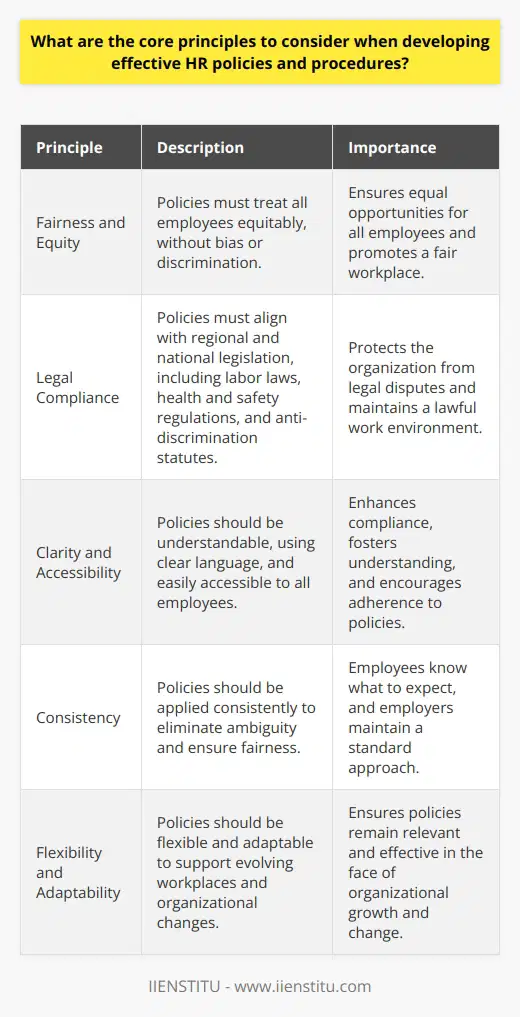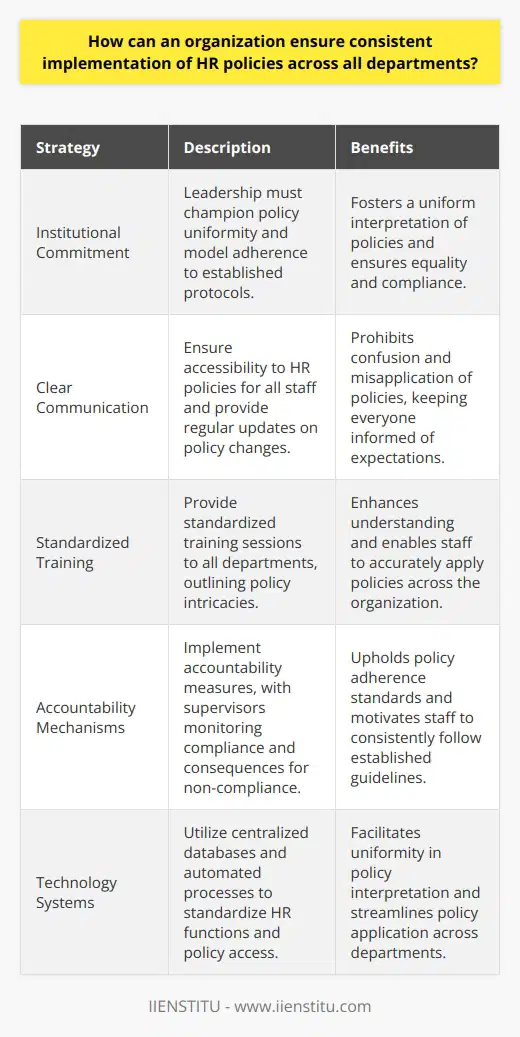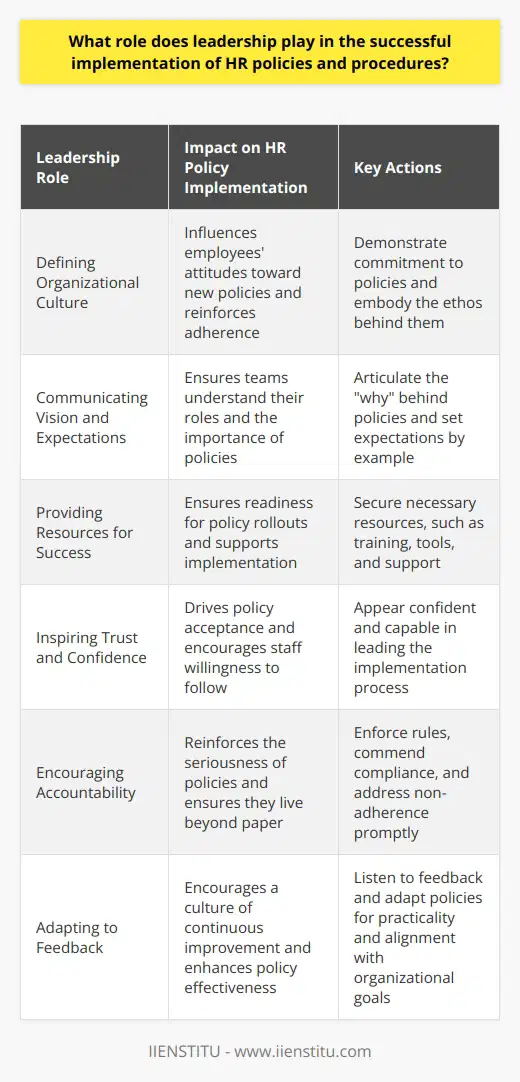
I still remember the day I stepped into my first role in human resources. Fresh out of college, clutching my degree like a golden ticket to the world of HR management, I was eager to make a difference. Little did I know that the real ticket to success in this field wasn't just my enthusiasm but understanding and implementing effective HR policies and procedures. Over the years, I've come to appreciate how these guidelines are not just bureaucratic necessities but the lifeblood of any thriving organization.
The Heartbeat of Organizations: HR Policies and Procedures
You see, in modern business, the strategic importance of HR policies and procedures cannot be overstated. They're like the unsung heroes, working behind the scenes to ensure everything runs smoothly. Acting as the backbone of organizational practice, these guidelines dictate not only the day-to-day management of personnel but also frame an organization's corporate culture and legal compliance. Effective HR policies and procedures serve as a bedrock upon which companies can build a robust and reliable human resources department, propelling all facets of the business forward.
A Walk Down Memory Lane
Reflecting on my journey, there was a time when our company faced significant challenges due to a lack of clear HR policies. We had talented people, great products, but something was amiss. It wasn't until we sat down and crafted comprehensive HR policies and procedures that we began to see a transformation. It was a classic case of not realizing what you need until it's missing.
Understanding the Core Components
Definition of HR Policies
So, what exactly are HR policies? Think of them as a broad orientation of an organization's ethos. They establish a blueprint for behavior and decision-making within the workplace. Each policy outlines a pre-determined approach to align with the company's values, vision, and legal obligations. As instructional and guideline documents, these policies insulate the organization by ensuring all employees are pulling in the same direction. This alignment helps avoid missteps resulting from ambiguity or subjectivity in corporate governance.
Definition of HR Procedures
Now, where policies provide the overarching framework, HR procedures specify the step-by-step methods required to carry out such directives. These detailed courses of action are tangible representations of policies in motion. They depict the implementation process from start to finish. Through these procedures, businesses operationalize their HR policies, translating conceptual guidelines into actionable tasks that are reflected across various facets of day-to-day operations.
Bringing It to Life with Examples
To illustrate, consider the recruitment and selection policy. It establishes an organization's commitment to equal opportunity and delineates the procedural steps involved in:
1- Advertising positions
2- Conducting interviews
3- Hiring new staff
Similarly, the learning and development policy underscores an investment in continuous employee improvement, while its procedures outline the logistical aspects of training initiatives. Moreover, disciplinary and dispute resolution procedures showcase the application of policies in managing conflict and ensuring a respectful and legally compliant workplace.
The Multifaceted Benefits
Clear Communication and Consistency
Enforcing HR policies and procedures fosters clear communication and consistency within an organization. Promoting transparency dissolves ambiguity and creates an environment where expectations are well-known and uniformly applied. This structural integrity is invaluable in guiding employees' conduct and providing a framework within which they can function confidently and efficiently.
I recall a time when our team was unsure about the process of requesting reassignment. The lack of a reassignment request letter template caused confusion and delays. Once we established a clear policy and provided tips and information on how to proceed, the process became seamless. Employees appreciated the clarity, and it saved us countless hours of back-and-forth.
Mitigating Legal Risks
Adherence to appropriate laws and regulations is more than a formality; it protects against potential lawsuits and legal complications. Well-crafted HR policies and procedures ensure compliance with labor laws, safeguarding the business from the fallout of legal transgressions. This risk mitigation is essential in fostering an atmosphere of legal and ethical integrity.
Consider the field of human resource management; it's riddled with complex legal requirements. By keeping our policies up-to-date, we've managed to stay ahead of the curve, avoiding pitfalls that have tripped up less diligent organizations.
Creating a Conducive Work Culture
Trust, fairness, and a sense of shared mission are all byproducts of effective HR policies and procedures. They're instrumental in building cohesive and contented teams, thereby boosting morale and productivity. An enviably positive work culture emerges from these foundations, attracting superior talent and often resulting in reduced turnover and heightened organizational performance.
In my experience, when employees feel that there's a fair and transparent system, they're more likely to invest themselves fully in their work. It's like when you know the rules of a game; you can play with confidence and creativity.
Creating Effective HR Policies and Procedures
Involvement of Stakeholders
The genesis of any effective HR policy is predicated on the involvement of various stakeholders. Input from employees, for instance, can provide ground-level insights that enrich policy formulation. Similarly, consultation with managers and executives guarantees alignment with overarching company strategy and goals, ensuring that HR initiatives are suitably integrated with broader business objectives.
A Collaborative Approach
When we developed our new performance appraisal system, we didn't do it in isolation. We:
Held focus groups with employees
Consulted with department heads
Collaborated with legal counsel
This collaborative approach ensured that the new system was fair, compliant, and well-received.
Legal Compliance
When devising HR policies and procedures, the company must remain conversant with and strictly abide by relevant legislation. Furthermore, regular updates are essential to keep pace with the ever-changing landscape of employment law, precluding organizational risk from outdated practices.
Clarity and Accessibility
Another cornerstone of effective HR policies and procedures is their clarity and accessibility. By using simple and concise language, organizations can sidestep misunderstandings and ensure that all employees fully grasp the guidelines that pertain to them. Consistent efforts should ensure that these documents are readily available and easily understandable to the workforce.
Tips for Enhancing Accessibility
Use clear headings and subheadings
Provide summaries or FAQ sections
Ensure policies are available in multiple languages if necessary
Regular Review and Update
Lastly, successful HR policies and procedures are not static; they must be adaptive, reflecting the dynamism of the business environment. This necessitates a commitment to periodic reviews, assessing their continued relevance and effectiveness, and amending them to address changing business needs, cultural shifts, and regulatory demands.
I remember being caught off-guard by a change in data protection laws. Our policies hadn't been updated, and we had to scramble to make necessary adjustments. Since then, we've scheduled annual reviews to prevent such lapses.
Navigating the Challenges
Resistance from Employees
Change is often met with resistance; thus, it is crucial to manage the introduction of new or revised HR policies and procedures effectively. Addressing employee fears and concerns through clear communication and supportive change management practices can mitigate this resistance and foster a smoother transition.
Inconsistent Application
Inconsistency in their application undermines the credibility of HR policies and procedures. Therefore, it is imperative to ensure fairness and equality are not just stated ideals but actualities reinforced by vigilant monitoring and corrective measures to rectify any irregularities.
Keeping Up with Legal Changes
The legal environment pertinent to HR is perpetually evolving. As such, organizations must prioritize regular training and consider enlisting legal experts to maintain currency and comprehensive compliance within their HR practices.
The Role of HR as a Catalyst for Success
Casting a retrospective glance over the topics discussed, the critical relevance of effective HR policies and procedures is firmly highlighted. They are not mere formalities but essential cogs in the machinery of business success, reflected in the operational harmony, legal security, and cultural vibrancy they sustain. Hence, the role of HR as a catalyst for business success is clear; these policies and procedures are the strategic enablers of an organization's greatest asset—its people.
Personal Reflections
As someone who has walked the path of HR for many years, I've seen firsthand how transformational robust HR policies and procedures can be. They've been the compass guiding us through turbulent times and the foundation upon which we've built a resilient organization.
Bringing It All Together
In conclusion, the strategic implementation of HR policies and procedures is not just about ticking boxes or adhering to regulations. It's about creating an environment where employees feel valued, informed, and aligned with the company's goals. By investing time and resources into developing and maintaining these guidelines, organizations set themselves up for long-term success.
Key Takeaways
1- Involve stakeholders at all levels when creating policies.
2- Ensure legal compliance to mitigate risks.
3- Prioritize clarity and accessibility of all documents.
4- Regularly review and update policies to stay current.
5- Address challenges proactively to ensure smooth implementation.
References
1- Armstrong, M. (2014). Armstrong's Handbook of Human Resource Management Practice. Kogan Page Publishers.
2- Dessler, G. (2017). Human Resource Management. Pearson Education Limited.
3- Storey, J. (2007). Human Resource Management: A Critical Text. Thomson Learning.
4- Torrington, D., Hall, L., & Taylor, S. (2008). Human Resource Management. Prentice Hall.
5- Boxall, P., & Purcell, J. (2016). Strategy and Human Resource Management. Palgrave Macmillan.
By integrating these practices, any organization, whether a budding startup or an established enterprise, can harness the full potential of its human resources. After all, at the heart of every company are the people who drive its success.
Frequently Asked Questions
What are the core principles to consider when developing effective HR policies and procedures?
Core Principles in HR Policy Development
When crafting HR policies, one must ground them in core principles. These principles ensure fairness, clarity, and consistency. Below are fundamental considerations for effective HR policy development.
Fairness and Equity
Fairness stands paramount. Policies must treat all employees equitably. This requires an objective approach. Bias and discrimination have no place. Equity means equal opportunity for all.
Legal Compliance
Adherence to law is essential. All policies must align with regional and national legislation. This includes labor laws, health and safety regulations, and anti-discrimination statutes.
Clarity and Accessibility
Policies need clarity. They should be understandable. Complex language confuses and deters. A clear policy enhances compliance.
Accessibility is key. Employees should access policies easily. Availability fosters understanding and adherence.
Consistency
Consistency ensures fairness. It eliminates ambiguity. Employees know what to expect. Employers maintain a standard approach.
Flexibility and Adaptability
Organizations evolve. So must policies. Flexibility allows for adjustments. Adaptability ensures relevance. Policies that can adapt support evolving workplaces.
Transparency
Employees trust transparent processes. Transparency builds that trust. It includes clear rationale for policies. Also, stakeholders should have insight into policy creation.
Engagement and Communication
Employee involvement is crucial. It brings diverse perspectives. Engagement leads to buy-in. Effective communication simplifies policy dissemination. It clarifies expectations and reduces uncertainty.
Regular Review and Update
Employers must review policies frequently. This ensures continued relevance. Updates keep policies aligned with changing laws and norms.
Reflect Organizational Culture and Values
Policies should mirror organizational values. They convey what the organization stands for. They set the tone for the workplace culture.
Support Business Strategy
Policies must support organizational objectives. They should align with business strategy. Misalignment hinders organizational performance.
Protect Employee and Employer Interests
Protection is vital for both parties. Policies must safeguard employee rights. They should also shield the employer from legal disputes.
In conclusion, these principles guide effective HR policy development. They ensure a robust framework for managing workplace issues. They promote a culture of fairness, trust, and legal compliance. Balancing these principles can be challenging. Yet, it is vital for a successful organization.

How can an organization ensure consistent implementation of HR policies across all departments?
Consistent HR Policy Implementation
Organizations straddle complex environments. Varied departments function under one umbrella. Each has unique dynamics, personnel, and culture. Within such diversity, HR policy uniformity appears daunting. Yet, it remains crucial for cohesive operations. Inconsistent practices spark discord and erode trust. Adherence to established protocols ensures equality and compliance.
Institutional Commitment Reflects in Policies
Firstly, leadership commitment stands paramount. Leaders must champion policy uniformity. They set the tone. Their actions must model policy adherence. Strong leadership fosters a uniform interpretation of policies.
Communication Facilitates Clarity
Clear communication is foundational. All staff need accessibility to HR policies. Such access ensures everyone understands expectations. Regular updates must address policy changes promptly. These practices prohibit confusion and misapplication.
Training Enhances Understanding
Training bolsters consistent implementation. Departments must receive standardized training sessions. These sessions should outline policy intricacies. Staff can thus accurately apply them.
Accountability Upholds Standards
Accountability mechanisms must underpin policy adherence. Supervisors bear the responsibility to monitor compliance. They ensure departmental actions align with organizational policies. Staff must know non-compliance consequences. Equally, consistent commendation for compliance motivates adherence.
Tailored Strategies Address Department Needs
Each department has unique needs. Tailoring strategies can accommodate these nuances. Customized approaches ensure policies fit varied department realities. Such tailoring should not compromise the policy core. The essence remains consistent; the application adjusts subtly.
Feedback Mechanisms Foster Improvement
Regular feedback mechanisms contribute to policy refinement. Staff should have channels to voice concerns. Feedback loops can identify implementation hurdles. Such insights prompt necessary adjustments. Policy evolution becomes a continual process. Improvement becomes the hallmark of responsive HR management.
Systems and Processes Standardize Practices
Technology systems facilitate uniformity. Centralized databases can host all HR policies. Departments access the same documents and interpretations. Automated processes can standardize core HR functions. These technologies streamline policy application.
Regular Audits Ensure Compliance
Periodic audits provide oversight. These audits assess policy compliance across departments. Discrepancies become apparent. Swift action can then rectify deviations.
Cross-Departmental Collaboration Harmonizes Efforts
Cross-departmental meetings enable collaboration. Shared understanding of policies emerges from such dialogue. Departments can discuss implementation challenges. Together, they develop cohesive solutions.
Leadership Involvement Maintains Alignment
Lastly, leadership must stay involved. They must review policy implementation regularly. Their concern signals the importance of uniformity. Leadership reviews can reiterate the centrality of consistent HR practices.
In summary, organizations can achieve HR policy consistency through deliberate measures. Commitment, communication, training, and technology are key. Accountability and audits maintain standards. Tailored approaches and cross-departmental collaboration address specific challenges. Leadership sustains alignment. Such efforts culminate in the robust and standardized application of HR policies.

What role does leadership play in the successful implementation of HR policies and procedures?
The Importance of Leadership in HR Policy Implementation
Leadership stands at the center of HR policy execution. It signals priority, sets the tone, and governs compliance. Strong leaders embody the ethos behind these policies. They champion the cause and steer teams toward adherence.
Leaders Define Organizational Culture
Leaders sculpt organizational culture. Culture roots from the top and cascades down. It influences employees' attitudes toward new policies. Leaders must demonstrate commitment. Teams mimic these behaviors, reinforcing policy adherence.
Leaders Communicate Vision and Expectations
Clarity in vision is paramount. Leaders must articulate the "why" behind policies. They set expectations by example. Clear communication ensures teams understand their roles.
Leaders Provide Resources for Success
Successful policy rollouts require resources. Leaders secure these resources. They provide training, tools, and support. Readiness hinges on these resources' availability.
Leaders Inspire Trust and Confidence
Trust drives policy acceptance. Leaders instill this trust. They must appear confident and capable. Their confidence translates into staff willingness to follow.
Leaders Encourage Accountability
Accountability ensures policies live beyond paper. Leaders enforce rules. They commend compliance and address non-adherence promptly. Their actions reinforce the seriousness of policies.
Leaders Adapting to Feedback
Adjustment is part of implementation. Leaders listen to feedback. They adapt policies for practicality and effectiveness. Responsiveness encourages a culture of continuous improvement.
The Role of Leadership in Policy Development
Leaders also play a crucial role in the design stage of HR policies. Their insights help craft realistic and impactful policies that align with organizational goals. Moreover, policies developed with leadership input are more likely to garner respect and adherence from employees, because they reflect an understanding of the day-to-day realities employees face.
In conclusion, leadership is the linchpin in successful HR policy implementation. It molds organizational culture, communicates effectively, ensures resource availability, instills trust, promotes accountability, and adapts to feedback. Without strong leadership, HR policies risk failing to take root, therefore diminishing their potential to effect positive organizational change.



